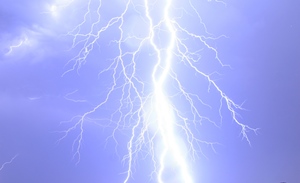Sun's 'magnet' pulls lightning towards UK, Reading scientists discover
Release Date 19 November 2014

The Sun may be playing a part in the generation of lightning strikes on Earth by temporarily ‘bending' the Earth's magnetic field and allowing a shower of energetic particles to enter the upper atmosphere.
This is according to researchers at the University of Reading who have found that over a five year period the UK experienced around 50% more lightning strikes when the Earth's magnetic field was skewed by the Sun's own magnetic field.
The Earth's magnetic field usually functions as an in-built force-field to shield against a bombardment of particles from space, known as galactic cosmic rays, which have previously been found to prompt a chain-reaction of events in thunderclouds that trigger lightning bolts.
It is hoped these new insights, which have been published today, 19 November, in IOP Publishing's journal Environmental Research Letters, could lead to a reliable lightning forecast system that could provide warnings of hazardous events many weeks in advance.
To do so, weather forecasters would need to combine conventional forecasts with accurate predictions of the Sun's spiral-shaped magnetic field known as the heliospheric magnetic field (HMF), which is spewed out as the Sun rotates and is dragged through the solar system by the solar wind.
Lead author of the research Dr Matt Owens said: "We've discovered that the Sun's powerful magnetic field is having a big influence on UK lightning rates.
"The Sun's magnetic field is like a bar magnet, so as the Sun rotates its magnetic field alternately points toward and away from the Earth, pulling the Earth's own magnetic field one way and then another."
In their study, the researchers used satellite and Met Office data to show that between 2001 and 2006, the UK experienced a 50% increase in thunderstorms when the HMF pointed towards the Sun and away from Earth.
This change of direction can skew or ‘bend' the Earth's own magnetic field and the researchers believe that this could expose some regions of the upper atmosphere to more galactic cosmic rays-tiny particles from across the Universe accelerated to close to the speed of light by exploding stars.
"From our results, we propose that galactic cosmic rays are channelled to different locations around the globe, which can trigger lightning in already charged-up thunderclouds. The changes to our magnetic field could also make thunderstorms more likely by acting like an extra battery in the atmospheric electric circuit, helping to further ‘charge up' clouds," Dr Owens continued.
The results build on a previous study by University of Reading researchers, also published in Environmental Research Letters, which found an unexpected link between energetic particles from the Sun and lightning rates on Earth.
Professor Giles Harrison, head of Reading's Department of Meteorology and co-author of both studies, said: "This latest finding is an important step forward in our knowledge of how the weather on Earth is influenced by what goes on in space. The University of Reading's continuing success in this area shows that new insights follow from atmospheric and space scientists working together."
Dr Owens continued: "Scientists have been reliably predicting the solar magnetic field polarity since the 1970s by watching the surface of the Sun. We just never knew it had any implications on the weather on Earth. We now plan to combine regular weather forecasts, which predict when and where thunderclouds will form, with solar magnetic field predictions. This means a reliable lightning forecast could now be a genuine possibility."
The scientific paper is freely available and can be downloaded from Environmental Research Letters.
Reference:
The published version of the paper ‘Modulation of UK lightning by heliospheric magnetic field polarity' (M J Owens et al 2014 Environ. Res. Lett. 9 115009) is available at http://iopscience.iop.org/1748-9326/9/11/115009/article